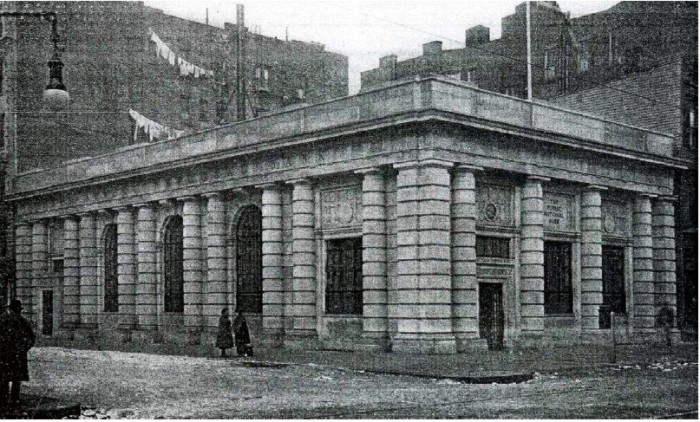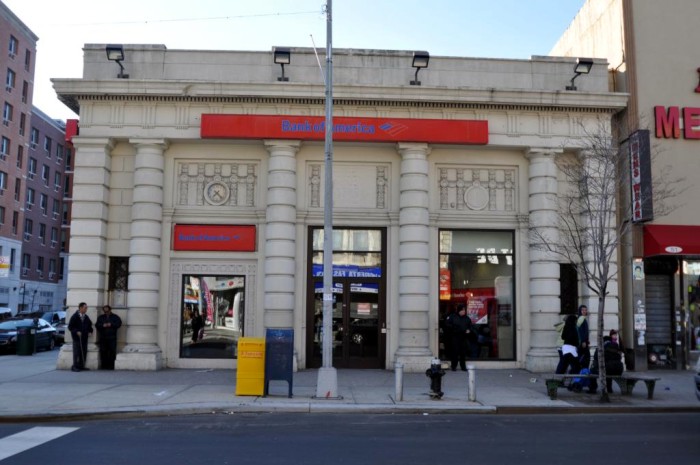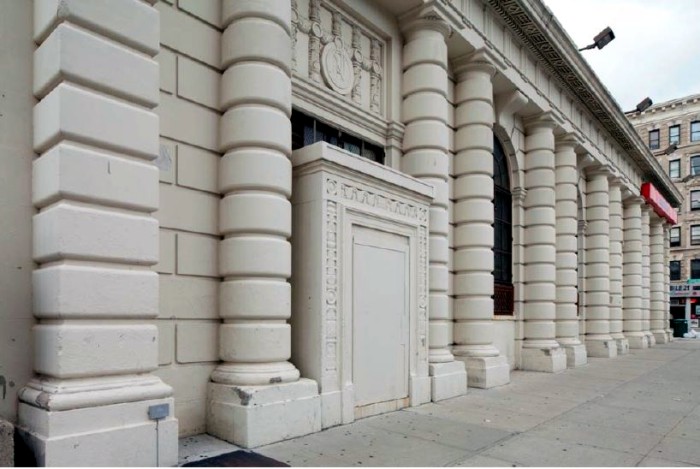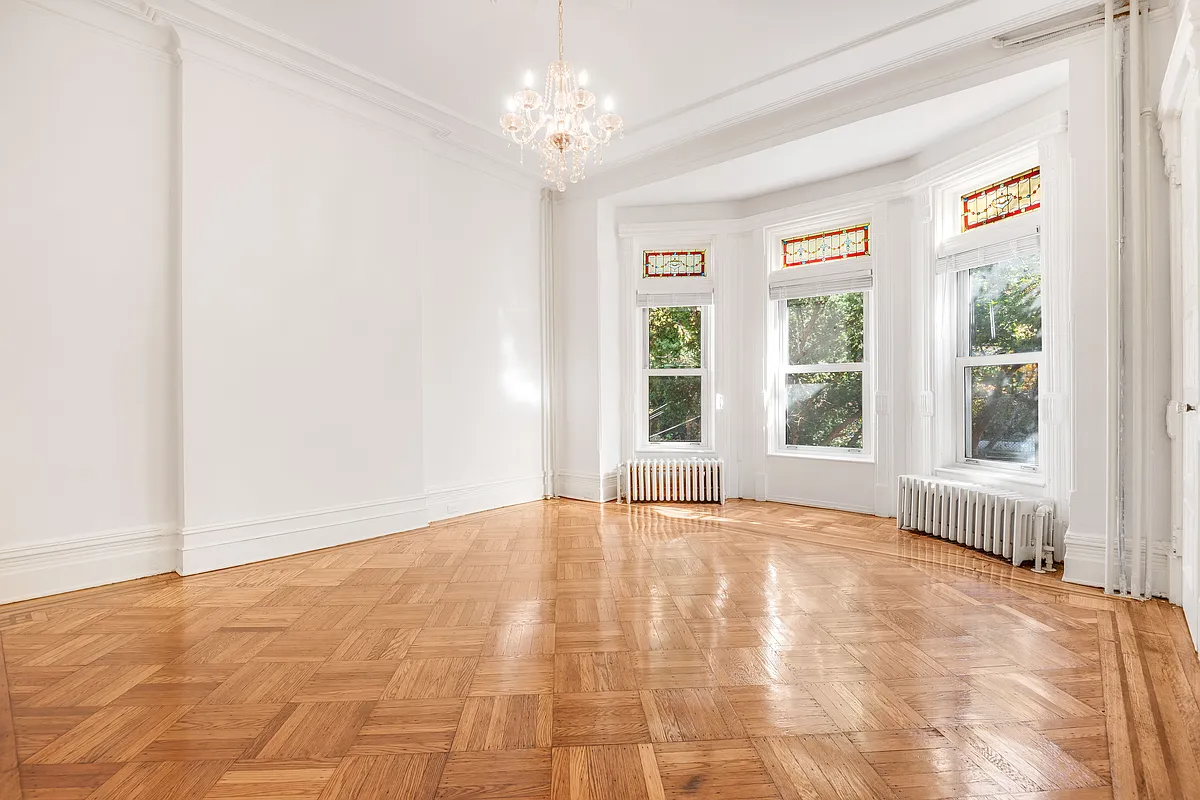Building of the Day: 47-49 Graham Avenue
Editor’s note: An updated version of this post can be viewed here. Brooklyn, one building at a time. Name: Originally Public National Bank of New York, now Bank of America Address: 47-49 Graham Avenue Cross Streets: Corner Varet Street Neighborhood: East Williamsburg Year Built: 1921-1923 Architectural Style: Neo-Classical Architect: Eugene Schoen Other works by architect:…

Editor’s note: An updated version of this post can be viewed here.
Brooklyn, one building at a time.
Name: Originally Public National Bank of New York, now Bank of America
Address: 47-49 Graham Avenue
Cross Streets: Corner Varet Street
Neighborhood: East Williamsburg
Year Built: 1921-1923
Architectural Style: Neo-Classical
Architect: Eugene Schoen
Other works by architect: other branches of Public Nat’l Bank; several synagogues, and factories. Best known as a furniture and interior designer.
Landmarked: Yes, individual landmark (2012)
The story: The Public National Bank was founded by Joseph S. Marcus, a German-born clothing manufacturer on the Lower East Side, in 1908. By 1930, there were thirty branches in Manhattan, Brooklyn and the Bronx. It was the one of the largest banks in the entire United States with a predominantly Jewish clientele. In February of 1921, the New York Times and other publications noted that the bank had purchased a plot on the corner of Graham Avenue and Varet Street with the intention of building a new Williamsburg branch. Public National already had a branch in Williamsburg, just two blocks away, but business had grown to the point that they needed to build a larger bank in order to accommodate their customers. Later that same year the architect of the new building was announced: Eugene Schoen.
Mr. Schoen was a big deal in the architecture and design world of the early 20th century. He was born in 1880, in New York City to Hungarian Jewish immigrants. His father had come to America in 1878, and was a highly revered teacher and the Grand Secretary of the Independent Order of B’rith Abraham, a fraternal order similar to the Freemasons. He was a graduate of the Manual Training School in Brooklyn, more recently called John Jay High School, and then went on to Columbia University, where he studied architecture. He worked in the offices of McKim, Mead & White during his university summers, and then worked as a teacher of art and architecture in the public school systems of Manhattan and Brooklyn.
In 1904, as a delayed honeymoon, Eugene and his wife travelled to Europe and visited Vienna. That city was at the center of a new architectural and artistic revolution, home to an Austrian branch of the Art Nouveau movement called the Vienna Secession (Wiener Secession). Artists such as Gustav Klimt and Max Klinger had joined with architects such as Otto Wagner, Joseph Maria Olbrich and Josef Hoffmann to rebel from the staid Austrian conformities of the past, and were creating new and innovative works. While in Austria, Schoen met with Otto Wagner who introduced him to Josef Hoffmann and artist Alphons Mucha. Schoen was especially taken with Hoffmann’s work, and was highly influenced by it. When he returned to NY, he worked many of Hoffmann’s influences into his own work, both in architecture and interior and furniture design.
Back in the US, Schoen went into practice with several partners, including a stint with Axel Hedman, the Swedish-born master of the Renaissance Revival row house. They were partners between 1908 and around 1915. They designed several synagogues in Manhattan, Brooklyn and Queens during that time period, as well as a couple of factories. On his own, in 1909-10, Schoen designed Shaari Zedek at 767 Putnam Avenue, in Stuyvesant Heights.
In 1915, Eugene Schoen announced that he was forming a company called the Bankers Engineering Company, which would be consultants to the banking industry on matters of “construction, remodeling and equipping banking houses.” It was as the head of this company that he received the lucrative and important patronage of the Public National Bank. He held this position until around 1930, during which time he designed many of the firm’s banks, including this one.
The bank is a one story structure in cast stone, now painted. It’s very much influenced by the Secessionist Movement, as well as incorporating classical elements. Part of the reason the bank was landmarked was because it is a rare example of early 20th century Viennese inspired architecture in New York City.
Eugene Schoen had another full career after he more or less abandoned architecture for interior design. He worked with such luminaries as Donald Deskey and Isamu Noguchi. There is much more to his story, which I will be sure to tell at another time. In 1955 the Public National Bank merged with Banker’s Trust of New York, which merged with National Westminster Bank in 1981. Today it is a branch of the Bank of America. GMAP
(Photo:Christopher Bride for Property Shark)












What's Your Take? Leave a Comment